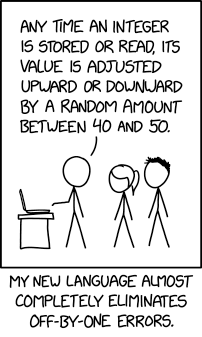Off By One

It does come at the small cost of a LOT more off-by-40-or-50 errors.

It does come at the small cost of a LOT more off-by-40-or-50 errors.
In computer programming and computer science, an off-by-one error is a very common human mistake made by an engineer who instructed the computer to process one too many or one too few items than are actually present. This can arise from a number of sources, including:
- Mistakenly using a ≤ (less than or equals) comparison where a < (less than) comparison was needed to terminate a loop or, alternately, ≥ mixed up with >.
- Imagine a literal interpretation of "When you get to the last task, you are done." (which means you don't need to complete the final task) as opposed to "When you have completed the last task, you are done".
- Confusion between zero- and one-based indexing of arrays in code, either by convention or by definition in the code. Often, when numbering (indexing) elements in programming, counting starts from 0, so the initial element is not the "first" but actually the "zeroth". When using an array data structure, where elements are stored at equally spaced memory addresses, zero-indexing lets you calculate the address of the ith element more easily: address(i) = address(array) + spacing × i. However, not all programming languages do this.
- Imagine a set of detailed instructions for washing dishes using a loop that starts with "put away any dish in your hands and pick up the next dish". If you read the instructions with a dish already in your hand, that first dish will never get washed.
- Fencepost errors (which some consider to be synonymous with off-by-one errors). These are often related to the norm, in programming language loop constructs, to require inclusivity on the lower side of the range but exclusivity on the upper side [min ≤ i < max). Consider the length of a range, such as the whole numbers from 4 to 6. If this is considered inclusive on one side and exclusive on the other, then the correct length is 2, to count the set {4, 5}. This is easily obtained via the subtraction max − min. However, if the range is considered inclusive on both sides, as when placing fenceposts to hold a length of fence, then the correct length is 3, to count the set {4, 5, 6}. This is one more than the difference, and one more than the length usually used in software engineering, so the formula for this case is actually max − min + 1.
- Imagine you are building a fence, with 1-meter panels between fenceposts. To build a 10-meter fence you need 11 fenceposts, as you need an "extra" one at the end. If you assume that a 10-meter fence needs 10 fenceposts, one per panel, you have a fencepost error — the correct algorithm is that you need one fencepost plus one per panel.
Cueball has attempted to combat off-by-one errors in his new programming language by introducing off-by-40-to-50 errors, which will indeed ensure that a simple reference to a value is never off by one (only a further, nearly complementary invocation of the ±[40..50] error will produce such a seemingly simple error). This severe change would introduce immediate failures in almost every program that does not have efficient error-catching and fault-tolerance. A programmer attempting to correct such failures would end up completely removing direct comparison with the end value of a range, the usual cause of off-by-one errors, but would have to account for the possibilities of all of their values being at least 50 off from the intended value in every elemental variable read/write (possibly multiple cases of this per statement, or line). For example, a normal loop can miss many elements (and possibly revisit others more than once, and/or out of order), not just possibly omit or over-extend one of the endpoints.
The title text states the obvious; by changing every number by 40 to 50, any number will be 40 to 50 off. This will compound further as the change can happen many times on a single line, as well as further by existing unforced off-by-one errors (or itself being left ill-defined or misunderstood, depending on whether "between" here is being understood as inclusive or exclusive) leading to potential off-by-39-to-51 errors. The title text can be used to infer that the 40-to-50 range is inclusive on both ends, despite the word "between" also possibly implying an exclusive range, in different contexts.